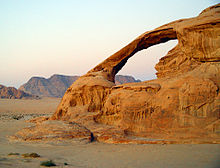
Erosion is the action of surface processes (such as water flow or wind) that removes soil, rock, or dissolved material from one location on the Earth's crust and then transports it to another location where it is deposited. Erosion is distinct from weathering which involves no movement.[1][2] Removal of rock or soil as clastic sediment is referred to as physical or mechanical erosion; this contrasts with chemical erosion, where soil or rock material is removed from an area by dissolution.[3] Eroded sediment or solutes may be transported just a few millimetres, or for thousands of kilometres.
Agents of erosion include rainfall;[4] bedrock wear in rivers; coastal erosion by the sea and waves; glacial plucking, abrasion, and scour; areal flooding; wind abrasion; groundwater processes; and mass movement processes in steep landscapes like landslides and debris flows. The rates at which such processes act control how fast a surface is eroded. Typically, physical erosion proceeds the fastest on steeply sloping surfaces, and rates may also be sensitive to some climatically controlled properties including amounts of water supplied (e.g., by rain), storminess, wind speed, wave fetch, or atmospheric temperature (especially for some ice-related processes). Feedbacks are also possible between rates of erosion and the amount of eroded material that is already carried by, for example, a river or glacier.[5][6] The transport of eroded materials from their original location is followed by deposition, which is arrival and emplacement of material at a new location.[1]
While erosion is a natural process, human activities have increased by 10–40 times the rate at which soil erosion is occurring globally.[7] At agriculture sites in the Appalachian Mountains, intensive farming practices have caused erosion at up to 100 times the natural rate of erosion in the region.[8] Excessive (or accelerated) erosion causes both "on-site" and "off-site" problems. On-site impacts include decreases in agricultural productivity and (on natural landscapes) ecological collapse, both because of loss of the nutrient-rich upper soil layers. In some cases, this leads to desertification. Off-site effects include sedimentation of waterways and eutrophication of water bodies, as well as sediment-related damage to roads and houses. Water and wind erosion are the two primary causes of land degradation; combined, they are responsible for about 84% of the global extent of degraded land, making excessive erosion one of the most significant environmental problems worldwide.[9]: 2 [10]: 1 [11]
Intensive agriculture, deforestation, roads, anthropogenic climate change and urban sprawl are amongst the most significant human activities in regard to their effect on stimulating erosion.[12] However, there are many prevention and remediation practices that can curtail or limit erosion of vulnerable soils.


- ^ a b "Erosion". Encyclopædia Britannica. 2015-12-03. Archived from the original on 2015-12-21. Retrieved 2015-12-06.
- ^ Allaby, Michael (2013). "Erosion". A dictionary of geology and earth sciences (Fourth ed.). Oxford University Press. ISBN 9780199653065.
- ^ Louvat, P.; Gislason, S. R.; Allegre, C. J. (1 May 2008). "Chemical and mechanical erosion rates in Iceland as deduced from river dissolved and solid material". American Journal of Science. 308 (5): 679–726. Bibcode:2008AmJS..308..679L. doi:10.2475/05.2008.02. S2CID 130966449.
- ^ Cheraghi, M.; Jomaa, S.; Sander, G.C.; Barry, D.A. (2016). "Hysteretic sediment fluxes in rainfall-driven soil erosion: Particle size effects" (PDF). Water Resour. Res. 52 (11): 8613. Bibcode:2016WRR....52.8613C. doi:10.1002/2016WR019314. S2CID 13077807.[permanent dead link]
- ^ Hallet, Bernard (1981). "Glacial Abrasion and Sliding: Their Dependence on the Debris Concentration In Basal Ice". Annals of Glaciology. 2 (1): 23–28. Bibcode:1981AnGla...2...23H. doi:10.3189/172756481794352487. ISSN 0260-3055.
- ^ Sklar, Leonard S.; Dietrich, William E. (2004). "A mechanistic model for river incision into bedrock by saltating bed load" (PDF). Water Resources Research. 40 (6): W06301. Bibcode:2004WRR....40.6301S. doi:10.1029/2003WR002496. ISSN 0043-1397. S2CID 130040766. Archived (PDF) from the original on 2016-10-11. Retrieved 2016-06-18.
- ^ Dotterweich, Markus (2013-11-01). "The history of human-induced soil erosion: Geomorphic legacies, early descriptions and research, and the development of soil conservation – A global synopsis". Geomorphology. 201: 1–34. Bibcode:2013Geomo.201....1D. doi:10.1016/j.geomorph.2013.07.021. S2CID 129797403.
- ^ Reusser, L.; Bierman, P.; Rood, D. (2015). "Quantifying human impacts on rates of erosion and sediment transport at a landscape scale". Geology. 43 (2): 171–174. Bibcode:2015Geo....43..171R. doi:10.1130/g36272.1.
- ^ Blanco-Canqui, Humberto; Rattan, Lal (2008). "Soil and water conservation". Principles of soil conservation and management. Dordrecht: Springer. pp. 1–20. ISBN 978-1-4020-8709-7.
- ^ Toy, Terrence J.; Foster, George R.; Renard, Kenneth G. (2002). Soil erosion : processes, prediction, measurement, and control. New York: Wiley. ISBN 978-0-471-38369-7.
- ^ Apollo, M.; Andreychouk, V.; Bhattarai, S.S. (2018-03-24). "Short-Term Impacts of Livestock Grazing on Vegetation and Track Formation in a High Mountain Environment: A Case Study from the Himalayan Miyar Valley (India)". Sustainability. 10 (4): 951. doi:10.3390/su10040951. ISSN 2071-1050.
- ^ Julien, Pierre Y. (2010). Erosion and Sedimentation. Cambridge University Press. p. 1. ISBN 978-0-521-53737-7.